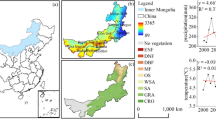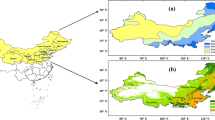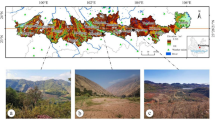Abstract
Drought has become a problem that is universally faced by global terrestrial ecosystems. Northeast China is located in a region sensitive to global climate changes, and one of the main impacts of climate changes in Northeast China is manifested as drought in growing seasons. This study analyzes the spatio-temporal evolution law of the water use efficiency (WUE) of the main natural vegetation (i.e., cold-temperate coniferous forests, temperate pine-broad-leaved mixed forests, warm-temperate deciduous broad-leaved forests, and grasslands) in Northeast China based on public MODIS data products, including MCD12Q1, MOD15A2H, MOD16A2, and MOD17A3H, and meteorological data from 2002 to 2013. The influence of drought events on the WUE of different vegetation types and their response to drought events are also investigated. The study findings are as follows: (1) drought in Northeast China frequently occurs in the regions stretching from 114.55°E to 120.90°E, and the percentage of drought area among the forests is lower than that among the grasslands during these years; (2) the annual average WUE of the natural vegetation ranges from 0.82 to 1.08 C/kg−1H2O, and the WUE of forests (0.82 to 1.08 C/kg−1H2O) is universally higher than that of grasslands (0.84 to 0.99 C/kg−1H2O; (3) in 2008, the regions where the WUE in drought conditions is higher than that in normal water conditions account for 86.11% of the study area, and a significant linear positive correlation is found between the WUE in drought conditions and the WUE in normal water conditions, whereas the degree of drought does not influence the WUE of the natural vegetation in an obviously linear manner; and (4) the WUE for the cold-temperate coniferous forests and temperate pine-broad-leaved mixed forests with a high ET or low NPP is more likely to rise in drought conditions; the WUE for the grasslands with a low Evapotranspiration (ET), Net Primary Production (NPP), and Leaf Area Index (LAI) is more likely to rise in drought conditions; and the ET, NPP, and LAI have no significant influence on the WUE for the warm-temperate deciduous broad-leaved forests in drought conditions. This study contributes to improving the evaluation of the influence of drought on natural ecosystems.
Similar content being viewed by others
References
Anower M R, Boe A, Auger D et al., 2017. Comparative drought response in Eleven Diverse Alfalfa accessions. Journal of Agronomy and Crop Science, 203(1): 1–13.
Aulia M R, Setiawan Y, Fatikhunnada A, 2016. Drought detection of west Java’s paddy field using MODIS EVI satellite images (Case Study: Rancaekek and Rancaekek Wetan). Procedia Environmental Sciences, 33: 646–653.
Campos G E P, Moran M S, Huete A et al., 2013. Ecosystem resilience despite large-scale altered hydro climatic conditions. Nature, 494: 349–352.
Chakroun H, Mouillot F, Nasr Z et al., 2014. Performance of LAI-MODIS and the influence on drought simulation in a Mediterranean forest. Ecohydrology, 7(3): 1014–1028.
Cracknell A P, Kanniah K D, Tan K P et al., 2015. Towards the development of a regional version of MOD17 for the determination of gross and net primary productivity of oil palm trees. International Journal of Remote Sensing, 36(1): 262–289.
da Silva J R, Patterson A E, Rodrigues W P et al., 2017. Photosynthetic acclimation to elevated CO2 combined with partial rootzone drying results in improved water use efficiency, drought tolerance and leaf carbon balance of grapevines (Vitis labrusca). Environmental and Experimental Botany, 134: 82–95.
Edwards C E, Ewers B E, McClung C R et al., 2012. Quantitative variation in water-use efficiency across water regimes and its relationship with circadian, vegetative, reproductive, and leaf gas-exchange traits. Molecular Plant, 5(3): 653–668.
Esmaeilpour A, Van L M C, Samson R et al., 2016. Variation in biochemical characteristics, water status, stomata features, leaf carbon isotope composition and its relationship to water use efficiency in pistachio (Pistacia vera L.) cultivars under drought stress condition. Scientia Horticulturae, 211: 158–166.
Friedl M A, Sulla-Menashe D, Tan B et al., 2010. MODIS Collection 5 global land cover: Algorithm refinements and characterization of new datasets. Remote sensing of Environment, 114(1): 168–182.
Gang C, Wang Z, Chen Y et al., 2016. Drought-induced dynamics of carbon and water use efficiency of global grasslands from 2000 to 2011. Ecological Indicators, 67: 788–797.
Hasibeder R, Fuchslueger L, Richter A et al., 2015. Summer drought alters carbon allocation to roots and root respiration in mountain grassland. New Phytologist, 205(3): 1117–1127.
Hernandez S V, Rodriguez D C M, Fernandez L J E et al., 2016. Role of leaf hydraulic conductance in the regulation of stomatal conductance in almond and olive in response to water stress. Tree Physiology, 36(6): 725–735.
Hobbins M T, Ramirez J A, Brown T C, 2001. The complementary relationship in estimation of regional evapotranspiration: An enhanced advection-aridity model. Water Resources Research, 37(5): 1367–1387.
Hoover D L, Duniway M C, Belnap J, 2017. Testing the apparent resistance of three dominant plants to chronic drought on the Colorado Plateau. Journal of Ecology, 105(1): 152–162.
Houghton J T, 1996. Climate Change 1995: The Science of Climate Change: Contribution of Working Group I to the Second Assessment Report of the Intergovernmental Panel on Climate Change. Cambridge: Cambridge University Press.
Huang X T, Luo G P, 2017. Spatio-temporal characteristics of evapotranspiration and water use efficiency in grasslands of Xinjiang. Chinese Journal of Plant Ecology, 41(5): 506–518. (in Chinese)
Iio A, Hikosaka K, Anten N P R et al., 2014. Global dependence of field-observed leaf area index in woody species on climate: A systematic review. Global Ecology and Biogeography, 23(3): 274–285.
Jin J X, Zhan W F, Wang Y et al., 2017. Water use efficiency in response to interannual variations in flux-based photosynthetic onset in temperate deciduous broadleaf forests. Ecological Indicators, 79: 122–127.
Joo E, Hussain M Z, Zeri M et al., 2016. The influence of drought and heat stress on long-term carbon fluxes of bioenergy crops grown in the Midwestern USA. Plant, Cell & Environment, 39(9): 1928–1940.
Killi D, Bussotti F, Raschi A et al., 2017. Adaptation to high temperature mitigates the impact of water deficit during combined heat and drought stress in C3 sunflower and C4 maize varieties with contrasting drought tol erance. Physiologia Plantarum, 159(2): 130–147.
Kuglitsch F G, Reichstein M, Beer C et al., 2008. Characterisation of ecosystem water-use efficiency of European forests from eddy covariance measurements. Biogeosciences Discussions, 5(6): 4481–4519.
Ledger M E, Edwards F K, Brown L E et al., 2011. Impact of simulated drought on ecosystem biomass production: An experimental test in stream mesocosms. Global Change Biology, 17(7): 2288–2297.
Li W, Zhao Y S, Zhou Z Q et al., 2012. Effects of drought stress and rehydration on chlorophy II fluorescence characteristics and antioxidant enzyme activities in leaves of Taxus cuspidate. Journal of Desert Research, 32(1): 112–116. (in Chinese)
Limousin J M, Yepez E A, McDowell N G et al., 2015. Convergence in resource use efficiency across trees with differing hydraulic strategies in response to ecosystem precipitation manipulation. Functional Ecology, 29(9): 1125–1136.
Lu H J, Mo X G, Meng D J et al., 2016. Analyzing spatiotemporal patterns of meteorological drought and its responses to climate change across Northeast China. Scientia Geographica Sinica, 35(8): 1051–1059. (in Chinese)
Lu X, Zhuang Q, 2010. Evaluating evapotranspiration and water use efficiency of terrestrial ecosystems in the conterminous United States using MODIS and America Flux data. Remote Sensing of Environment, 114: 1924–1939.
Ma J Y, Xu Y L, 2013. Temporal and spatial characteristics and circulation background of drought in crop growing season over Northeast China. Chinese Journal of Agrometeorology, 34(1): 81–87. (in Chinese)
Malone S L, Tulbure M G, Perez-Luque A J et al., 2016. Drought resistance across California ecosystems: Evaluating changes in carbon dynamics using satellite imagery. Ecosphere, 7(11): 1–19.
Mi Z R, Chen L T, Zhang Z H et al., 2015. Alpine grassland water use efficiency based on annual precipitation, growing season precipitation and growing season evapotranspiration. Chinese Journal of Plant Ecology, 39(7): 649–660. (in Chinese)
Monclus R, Dreyer E, Villar M et al., 2006. Impact of drought on productivity and water use efficiency in 29 genotypes of Populus deltoides×Populus nigra. New Phytologist, 169(4): 765–777.
Mu Q, Zhao M, Running S W, 2011. Improvements to a MODIS global terrestrial evapotranspiration algorithm. Remote Sensing of Environment, 115(8): 1781–1800.
Murray T G, Friedlingstein P, Sitch S et al., 2016. The dry season intensity as a key driver of NPP trends. Geophysical Research Letters, 43(6): 2632–2639.
Mutiibwa D, Irmak S, 2013. AVHRR-NDVI-based crop coefficients for analyzing long-term trends in evapotranspiration in relation to changing climate in the US High Plains. Water Resources Research, 49(1): 231–244.
Myneni R, 2015. MOD15A2H MODIS/Terra Leaf Area Index/FPAR 8-Day L4 Global 500 m SIN Grid V006. NASA EOSDIS Land Processes DAAC. https://doi.org/10.5067/MODIS/MOD15A2H.006.
Niu S, Xing X, Zhang Z H E et al., 2011. Water-use efficiency in response to climate change: From leaf to ecosystem in a temperate steppe. Global Change Biology, 17(2): 1073–1082.
PaiMazumder D, Done J M, 2016. Potential predictability sources of the 2012 US drought in observations and a regional model ensemble. Journal of Geophysical Research: Atmospheres, 121(21): 12581–12592.
Ponton S, Dupouey J L, Bréda N et al., 2002. Comparison of water-use efficiency of seedlings from two sympatric oak species: Genotype × environment interactions. Tree Physiology, 22(6): 413–422.
Raich J W, Potter C S, Bhagawati D, 2002. Interannual variability in global soil respiration, 1980–94. Global Change Biology, 8(8): 800–812.
Reichstein M, Tenhunen J D, Roupsard O et al., 2002. Severe drought effects on ecosystem CO2 and H2O fluxes at three Mediterranean evergreen sites: Revision of current hypotheses? Global Change Biology, 8: 999–1017.
Rosenberg N J, Blad B L, Verma S B, 1983. Microclimate: The Biological Environment. New York: John Wiley & Sons Press.
Ruehr N K, Law B E, Quandt D et al., 2014. Effects of heat and drought on carbon and water dynamics in a regenerating semi-arid pine forest: A combined experimental and modeling approach. Biogeosciences, 11(15): 4139–4156.
Running S W, Mu Q, Zhao M, 2015. MOD17A3H MODIS/Terra Net Primary Production Yearly L4 Global 500m SIN Grid V006. NASA EOSDIS Land Processes DAAC. https://doi.org/10.5067/MODIS/MOD17A3H.006.
Sawada Y, Koike T, Jaranilla-Sanchez P A, 2014. Modeling hydrologic and ecologic responses using a new eco-hydrological model for identification of droughts. Water Resources Research, 50(7): 6214–6235.
Schoo B, Wittich K P, Bottcher U et al., 2017. Drought tolerance and water-use efficiency of biogas crops: A comparison of cup plant, maize and lucerne-grass. Journal of Agronomy and Crop Science, 203(2): 117–130.
Shiogama H, Watanabe M, Imada Y et al., 2013. An event attribution of the 2010 drought in the South Amazon region using the MIROC5 model. Atmospheric Science Letters, 14(3): 170–175.
Stella P, Lamaud E, Brunet Y et al., 2009. Simultaneous measurements of CO2 and water exchanges over three agroecosystems in south-west France. Biogeosciences, 6(12): 2957–2971.
Turner D P, Ritts W D, Cohen W B et al., 2006. Evaluation of MODIS NPP and GPP products across multiple biomes. Remote Sensing of Environment, 102(3): 282–292.
Vanlerberghe G C, Martyn G D, Dahal K, 2016. Alternative oxidase: A respiratory electron transport chain pathway essential for maintaining photosynthetic performance during drought stress. Physiologia Plantarum, 157(3): 322–337.
Wang F, Jiang H, Zhang X, 2015. Spatial-temporal dynamics of gross primary productivity, evapotranspiration, and water-use efficiency in the terrestrial ecosystems of the Yangtze River Delta region and their relations to climatic variables. International Journal of Remote Sensing, 36(10): 2654–2673.
Wang J, Dong J, Yi Y et al., 2017. Decreasing net primary production due to drought and slight decreases in solar radiation in China from 2000 to 2012. Journal of Geophysical Research: Biogeosciences, 122(1): 261–278.
Wang S J, Song Y, 2006. Basic frame of the urban geography of Northeast China. Acta Geographica Sinica, 61(6): 574–584. (in Chinese)
Wang W, Chang X L, Liu L X et al., 2013. Trend of the eastern boundary of semiarid zone in Northeast. Journal of Desert Research, 33(2): 382–389. (in Chinese)
Wang Z L, Huang Z Q, Li J et al., 2016. Assessing impacts of meteorological drought on vegetation at catchment scale in China based on SPEI and NDVI. Transactions of the Chinese Society of Agricultural Engineering, 32(14): 177–186. (in Chinese)
Wang Z L, Li J, Huang Z Q et al., 2016. Spatiotemporal variations analysis of meteorological drought in China based on scPDSI. Transactions of the Chinese Society of Agricultural Engineering, 32(2): 161–168. (in Chinese)
Wells N, Goddard S, Hayes M J, 2004. A self-calibrating palmer drought severity index. Journal of Climate, 17: 2335–2351.
Wilson S D, 2007. Competition, resources, and vegetation during 10 years in native grassland. Ecology, 88(12): 2951–2958.
Xi Z X, Yang X Y, Liu S et al., 2016. The risk evaluation and division of the summer drought in Northeast China. Science Geographica Sinica, 33(6): 735–740. (in Chinese)
Xie J, Zha T S, Zhou C X et al., 2016. Seasonal variation in ecosystem water use efficiency in an urban-forest reserve affected by periodic drought. Agricultural and Forest Meteorology, 221: 142–151.
Xu W D, 1986. The relation between the zonal distribution of types of vegetation and the climate in Northeast China. Acta Phytoecologica et Geobotanica Sinica, 10(4): 254–263. (in Chinese)
Yang L, 2015. The influence of drought on water parameters of Larix gmelinii [D]. Harbin: Northeast Forestry University. (in Chinese)
Yu G R, Song X, Wang Q F et al., 2008. Water-use efficiency of forest ecosystems in eastern China and its relations to climatic variables. New Phytologist, 177(4): 927–937.
Yu K, Okin G S, Ravi S et al., 2016. Potential of grass invasions in desert shrublands to create novel ecosystem states under variable climate. Ecohydrology, 9(8): 1496–1506.
Zhang B H, Zhang L,Guo H D et al., 2014. Drought impact on vegetation productivity in the Lower Mekong Basin. International Journal of Remote Sensing, 35(8): 2835–2856.
Zhang Y, Xie J B, Li Y, 2017. Effects of increasing root carbon investment on the mortality and resprouting of Haloxylon ammodendron seedlings under drought. Plant Biology, 19(2): 191–200.
Zhang Y D, Pang R, Gu F X et al., 2016. Temporal-spatial variations of WUE and its response to climate change in alpine area of southwestern China. Acta Ecologica Sinica, 36(6): 1515–1525. (in Chinese)
Zhao D S, Wu S H, 2013. Responses of vulnerability for natural ecosystem to climate change in China. Acta Geographica Sinica, 68(5): 602–610. (in Chinese)
Author information
Authors and Affiliations
Corresponding author
Additional information
Foundation: Foundation of Northeast China Innovation and Opening Laboratory of Eco-Meteorology, CMA, No.stqx2017zd01; Special Projects of Climate Change of CMA, No.CCSF201512; Foundation of Institute of Atmospheric Environment in Shenyang, CMA, No.2016SYIAE11; National Natural Science Foundation of China, No.41165005
Rights and permissions
About this article
Cite this article
Liu, D., Yu, C. & Zhao, F. Response of the water use efficiency of natural vegetation to drought in Northeast China. J. Geogr. Sci. 28, 611–628 (2018). https://doi.org/10.1007/s11442-018-1494-9
Received:
Accepted:
Published:
Issue Date:
DOI: https://doi.org/10.1007/s11442-018-1494-9




